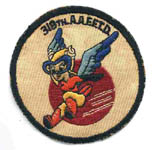"Fifinella"
WASP
Women
Airforce Service Pilots
Over 50 years ago, at a time when America was desperate for gasoline, money for war bonds and a few good men, something extraordinary happened. 1,830 young women pilots from all over America quit their jobs and left the safety of their homes and families to come to Texas. Some came by car, some by bus, others hitched or rode the train, a few even came by plane, but they all paid their own way. They came to Texas because their country needed them. They came to Texas because they loved to fly
The WASP were a unique corps of young women pilots, trained to fly “the Army way” by the U.S. Army Air Force at Avenger Field in Sweetwater, Texas. After completing months of military flight training, 1078 of them earned their wings and became WASP, Women Airforce Service Pilots, the first women in history to fly American military aircraft. The WASP were stationed at l20 air bases across the United States, relieving male pilots for combat duty. They flew more than 60 million miles ferrying aircraft from aircraft factories to ports of embarkation and military training bases, towing targets for live anti-aircraft artillery practice and live air-to-air gunnery practice, instructing male pilots, flight testing aircraft, flying night tracking missions and simulated straffing missions, transporting cargo -- in fact, flying every type of mission and every type of aircraft flown by the Army Air Force’ male military pilots. Thirty-eight WASP lost their lives while serving their country as military pilots, their bodies sent home in cheap pine boxes at the expense of their family or friends. These heroic women pilots were denied any military benefits or honors--no gold star in the window--not even so much as an American flag to drape their coffins.
Unlike the other women who served and received military benefits during WW II, the WASP were denied that same military status. Thirty-five years after their deactivation, Congress finally recognized their military service and granted them the veteran status they had earned--but without most of the benefits other veterans received
Regardless of their many accomplishments since their deactivation, the WASP’ most important legacy is their contribution as military pilots during World War II to ensure the continued freedom of America. Because of the pioneering efforts and the expertise they demonstrated in successfully flying every type of military aircraft, from the fastest fighters to the heaviest bombers, the WASP blazed a trail for the women of future generations to follow. The WASP had proven conclusively that female pilots, when given the same training as male pilots, can fly wingtip to wingtip with their brothers.
Their legacy is unrivaled, their history priceless..
